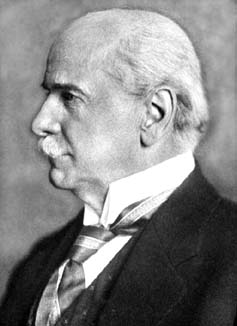
Walther Franz Anton von Dyck
 المؤلف:
J E Hofmann
المؤلف:
J E Hofmann
 المصدر:
Biography in Dictionary of Scientific Biography
المصدر:
Biography in Dictionary of Scientific Biography
 الجزء والصفحة:
...
الجزء والصفحة:
...
 3-3-2017
3-3-2017
 1197
1197
Born: 6 December 1856 in Munich, Germany
Died: 5 November 1934 in Munich, Germany

Perhaps we should first comment that Walther von Dyck was not known by precisely that name in his youth, but rather by the name Walther Dyck. He was ennobled with the "von" only much later in his life.
Walther's father was Hermann Dyck while his mother was Marie Royko. Hermann Dyck was a painter and he was the Director of the Kunstgewerbeschule in Berlin, that is the Berlin School of Industrial Art. Walther certainly inherited his father's artistic abilities but in addition he had a wide range of skills across the arts and sciences.
He studied at a number of German universities, which was the standard pattern for students at that time. After beginning his studies at the University of Munich, he then spent time studying at the Universities of Berlin and Leipzig. He received his doctorate from Munich in 1879 for a thesis entitled Über regulär verzweigte Riemannsche Flächen und die durch sie definierten Irrationalitäten. His thesis supervisor was Klein who had been appointed to a chair at the Technische Hochschule at Munich a few years before in 1875.
In 1880 Klein left Munich to take up the chair of geometry at Leipzig. Dyck went to Leipzig to take up a position as Klein's assistant and there he submitted his habilitation thesis, receiving the university lecturing qualification in 1882. During this period Dyck made important contributions to group theory with the publication of two papers; Gruppentheoretische Studien in Mathematische Annalen the first in 1882 and the second in the following year.
Klein would remain at Leipzig until 1886, but Dyck left two years before that when he was appointed professor at newly established Munich Polytechnikum. In [3] Dyck's work at the Munich Polytechnikum is studied in detail. In particular Hashagen, the author of [3], examines the way von Dyck tried to solve the problems which arose in the training of engineers. Von Dyck stressed how important a basic knowledge in mathematics was to engineers and he worked hard to construct a consistent course to include varied topics.
Dyck would remain at the Munich Polytechnikum for the rest of his career and gave outstanding service to it in many important ways. He was appointed Director of the Polytechnikum in 1900 and under his inspired leadership the institution rose to university status becoming the Technische Hochschule of Munich. He served as rector of the Technische Hochschule for two terms, the first from 1903 to 1906 and the second from 1919 to 1925.
There was another important project in which von Dyck played an important role. This was the creation of the Deutsches Museum of Natural Science and Technology. The idea was first suggested by Oskar von Miller who was an electrical engineer who was instrumental in setting up the electric power industry in Germany. In 1903 Miller enlisted the help of von Dyck and of Carl von Linde who had been appointed extraordinary professor of machine design at the Munich Polytechnikum in the same year as von Dyck was appointed. They proposed that a museum be built in Munich which would both preserve technological artefacts and let visitors learn about the scientific principles through interactive displays.
The Deutsches Museum was first of its kind and its ideas were soon copied by other science museums around the world. Not only was von Dyck one of the three to establish and develop the museum in its early stages, but he was also appointed as the second Director of the Museum in 1906.
Von Dyck made important contributions to function theory, group theory (where a fundamental result on group presentations is named after him), topology (where he was influenced by the work of Riemann), and to potential theory. He made significant contributions to the Gauss-Bonnet theorem.
Another important project which von Dyck undertook was one to publish the complete works of Kepler, including all Kepler's letters. He undertook this in his role as class secretary of the Bayerische Akademie der Wissenschaften in 1906. This project has extended well beyond von Dyck's lifetime with Volume 7 appearing in 1953, and Volume 8 in 1963.
Von Dyck's character and contribution are summed up in [1] as follows:-
Linguistically gifted and a warm, kind-hearted man of wide-ranging and liberal interests, including art and music, Dyck was an outstanding scholar and organiser and an enthusiastic and inspiring teacher.
- J E Hofmann, Biography in Dictionary of Scientific Biography (New York 1970-1990).
http://www.encyclopedia.com/doc/1G2-2830901272.html
Books:
- B Chandler and W Magnus, The history of combinatorial group theory : A case study in the history of ideas (New York-Berlin, 1982).
- U Hashagen, Walther von Dyck (1856-1934) (Gebundene Ausgabe) (Franz, 2003).
Articles:
- G Faber, Walther von Dyck, Jahresberichte der Deutschen Mathematiker-Vereinigung 45 (1935), 89-98.
- U Hashagen, Mathematik und Technik im letzten Drittel des 19. Jahrhunderts - eine bayerische Perspektive, in Carl Julius von Bach (1847-1931) (Stuttgart, 1998), 169-184,.
 الاكثر قراءة في 1850to1859
الاكثر قراءة في 1850to1859
 اخر الاخبار
اخر الاخبار
اخبار العتبة العباسية المقدسة


